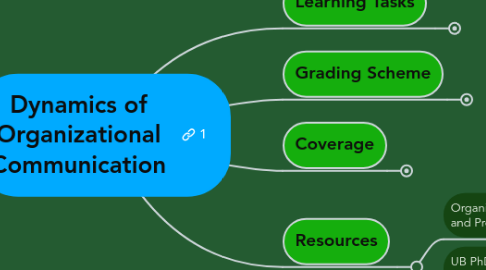
1. Learning Tasks
1.1. Oral & written reports
1.1.1. Substance & relevance of written report
1.1.2. Effectiveness of oral presentation
1.1.3. Compliance to prescribed standards
1.2. Active participation in group discussions
1.3. Synthesis of the course as experienced
2. Grading Scheme
2.1. Class participation 10%
2.1.1. Contextual: Willingness to participate and attentive to discussion
2.1.2. Innovative: There is willingness to test new ideas and comments are not confrontational.
2.1.3. Insightful: Comments are appropriate and indicates insightful analysis of case data
2.1.4. Relevant: Comments are relevant to current discussion and linked to comments of others
2.1.5. Supported: Comments clarify important aspects of earlier ideas and lead to clearer statement of relevant concepts and issues
2.2. Research Topics 45%
2.2.1. Slides Presentation
2.2.1.1. Presentation is professionally done
2.2.1.2. Not more than 30 slides (20 minutes)
2.2.1.3. Prescribed presentation standards
2.2.2. Written Report
2.2.2.1. Prescribed report format
2.2.2.2. Report is consistent and effectively sells its recommendations
2.2.2.3. Report is not long, 2000 words max
2.2.2.4. Exhibits
2.2.2.4.1. Analyses in the exhibits are done correctly
2.2.2.4.2. Exhibits support and clarify key points
2.2.2.4.3. 3 to 7 exhibits
2.3. Assignments 45%
2.3.1. Case Analysis
2.3.1.1. Quality analysis
2.3.1.1.1. Major issues are addressed
2.3.1.1.2. Relevant tools are used properly
2.3.1.1.3. Assumptions for analysis are stated clearly
2.3.1.1.4. Causes of the problems are identified in the analysis
2.3.1.2. Recommendations
2.3.1.2.1. Criteria for selecting alternative recommendations are given
2.3.1.2.2. Criteria are appropriate
2.3.1.2.3. Plan of action is logical linked to the analysis
2.3.1.2.4. Plan of action is specific, complete and practical
2.3.1.2.5. Recommendations are likely to achieve intended results
2.3.1.3. Prescribed format
2.3.2. Essays
